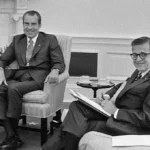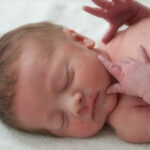Blog Post
Tales of Cruelty: The True Story of Communist China’s One Child Policy
By Jonathon Van Maren
On the day that Communist China formally ended the One Child Policy in 2015, it announced that the draconian law—launched in 1979 and written into the country’s constitution in 1982—had made China more powerful, the world more peaceful, and the people more prosperous. There was no mention of the global uproar caused by photographs of broken, unconscious women on beds with their dead babies lying next to them after being pulled from the womb, of the tens of millions of missing baby girls, or of the maelstrom of misery that family planning officials had brought to every village in the country. The One Child Policy ended as it began: With pleasant lies and colorful propaganda.
Filmmaker Nanfu Wang was born in 1985 in a little village in Jiangxi Province, and moved to the United States in her twenties. After becoming a mother herself, she began to reflect back on memories of her childhood in China and the politics of conception and childbirth. Unlike many families, she had a brother, and remembers being acutely embarrassed by this fact. The omnipresent propaganda of the Communist state made it clear that one child was the only acceptable sort of family, and this message was pounded into public consciousness through fancy folk plays, operas, children’s songs, and painted slogans, with traditional methods of storytelling weaponized to sell unnatural and modern ways of thinking about family. Wang wondered, thinking back, whether her thoughts about these things were actually her own, or if they had been planted there by the state.
Her decision to explore her family’s history and China’s One Child Policy is powerfully captured in the 2019 documentary, One Child Nation. Wang began by asking her mother how the policy had impacted her own family, and discovered that her mother had almost been forcibly sterilized after she was born, but her grandfather had successfully persuaded family planning officials to allow the family to try for a boy in five years. When her mother went into labor with her second child, her grandmother placed a bamboo basket on the floor and announced that if the child was a girl, they would pop her into the basket and leave her out in the street. This story was related calmly, as if throwing baby girls out was common. As Wang would soon discover, it was.
She decided to visit Huaru Yuan, the 84-year-old village midwife who had delivered her. The old woman’s kindly face seemed to defy the words coming out of her mouth. She wasn’t sure how many babies she’d delivered, she said, but she knew she’d done between 50,000 and 60,000 abortions: “I counted this out of guilt because I aborted and killed babies. Many I induced alive and killed. My hands trembled doing it. But I had no choice: it was the government’s policy.” The headman of the village echoed her sentiments as he confessed that houses had been destroyed and roofs torn off family homes if couples dared to have more than one child. “It might be cruel,” he said. “But policy is policy. What could we do?” Or as one propaganda slogan had it: “Better to shed a river of blood than to birth more than one child.”
Yuan retired from midwifery 27 years ago, and she now only treats infertility, her house filled with the baby photographs of those she had helped. “I want to atone for my sins,” she told Wang, her wrinkled hand stroking a photo of a fat, smiling baby. Despite the many healthy children she has ushered into the world, her conscience still torments her. “What goes around, comes around,” she said sadly. “There will be a retribution for me.” She noted that many of her colleagues had already died, and that she gives as much money as she can to charity. Many people have assured her that what she did wasn’t wrong—it was just a job. But Yuan knows better. “I was the executioner,” she said. And then a question: “I killed those babies, didn’t I?” It struck me, as I watched her speak, that China has not only forced people to do unspeakably cruel things; it has also banned the path to the Saviour who can forgive all things.
The stories Wang uncovered from the early days of the One Child Policy are nothing short of savage. Village doctors and medical teams essentially functioned as population control commandos, traveling about to do sterilisations and abortions. Children who were born before the abortions could be completed were drowned, strangled, or suffocated like unwanted strays. Back then, one female doctor recalled, many women—especially those in the rural areas—were unwilling to be sterilised, and the government officials had to kidnap them, ensuring that they were “tied up and dragged to us like pigs.” Sterilisations only took ten minutes, and she’d often do more than 20 a day, snipping futures on her operating table.
Black-and-white photographs show awful scenes: a young woman with tears streaming down her face, her features twisted in a grimace of pain and sorrow, her husband sitting next to her and holding their one allotted child, staring vacantly into the distance. He looks like a human shell, forbidden by the state to protect his wife from those who had assaulted and mutilated her. Another shows a young woman, her face a mask of grief, being dumped unceremoniously onto a makeshift pallet by several officials. Pregnant women would bolt in fear at the sight of family planning officials, and one prominent official told Wang that after they were caught and dragged back, things got worse: “during abortions women would cry, curse, fight, go insane.” One, she recalled with a laugh, ran off naked, and they told the Communist leader that she would be impossible to catch as there was nothing to grab onto.
It was chilling to watch the female official chuckle at someone’s moment of animal terror as she and her fellow officials carried out their gruesome work, but all these years later, she still maintains that the One Child Policy was a good one. She initially felt that forced abortions were an atrocity, she admitted, but her colleagues constantly reminded her that it was a privilege to do tough things for the Communist Party. There was a lot of death, but they were fighting a “population war”—against their own population—and in war, she said, there is always death. Her interview is cut with scenes of the planning official receiving awards for her work by the top dogs of Red China while a perky announcer calls for applause. It was a picture of pure totalitarianism—the Big Lie. It was not enough to say that the One Child Policy was a tragic necessity, or a necessary evil. No, it was declared to be a good thing. People were not just required to believe a falsehood, but to believe the precise opposite of the truth.
Wang also interviewed Peng Wang, an artist who fought to expose the One Child Policy through graffiti and other art. He’d always wondered, he told her, how nurses could kill, and eventually concluded that it was the propaganda and indoctrination. Above all, it was the idea that collective interests were above all else, an idea that destroys the individual conscience. He’d begun to explore the One Child Policy when in 1996, he found a dead baby in a plastic medical waste bag tossed on a trash heap under a bridge. The child transfixed him, and he began to render these lost children in his art in an attempt to preserve their memory and to ensure that the cruelties of the One Child Policy would not be forgotten as China moved on to a Two Child Policy.
He placed one fetus that he found in the garbage in a jar of formaldehyde, a perfect, peaceful baby sleeping in chemical fluid. The child is ethereal, and looks as if he might wake up at any moment, as if he is both there and not there at the same time. Perfect fingers curl around a perfect thumb, and his chubby feet look just like baby’s feet should. And yet, he had been tossed out with the trash: The One Child Policy did not mean that every family only had one child. It meant that the brothers and sisters of the chosen one would be killed, sold, or abandoned—loved only by strangers like Peng Wang, to be kept in a jar and admired. “He was a beautiful baby,” Wang said, gazing at the child. “But he was dead. A smile was still on his face. I was wondering: Why would he smile like that after being aborted and killed? It’s as if he knew it’d be miserable to be alive in China, and he was happy to have avoided it.”
Despite these cruelties, Wang discovered that even her family wouldn’t condemn the One Child Policy. Her mother defended it—it was policy, after all. That meant it had to be defended. Things were much worse for previous generations, she said, and perhaps the Chinese would have become cannibals with so many mouths to feed. Her grandfather admitted to her that he felt his grandsons were worth more than granddaughters, who would leave the family to join other families. And then her mother told her, as Wang stared in disbelief, that she had helped her younger brother discard his daughter—her niece—in the market so he could try again for a son. They left her on a table at the meat market, and for two days and nights she sat there. Nobody wanted her. Her face swarmed with mosquitos. “She died, and then we buried her.”
Wang went to talk to her uncle, who confirmed the story. His mother—Wang’s grandmother—had threatened to kill herself if the little girl wasn’t abandoned. She’d even threatened to strangle her granddaughter. Her uncle felt that perhaps by abandoning her to be picked up by someone else, he would be saving her life. Instead, she died, and he wept for days. But this was a commonplace tragedy, another aunt told Wang—baby girls were often left to die in the marketplace from exposure, their little bodies crawling with maggots. The aunt had passed off a baby girl to human traffickers who earned $45 per child from orphanages, which would then place them up for international adoption. Her aunt felt this was best for her daughter, but desperately missed her. Do you hate the One Child Policy? Wang asked her. “What’s to hate?” came the fatalistic response. “Policy is policy.”
The policy also spawned a strange human trafficking network. Wang spoke with one prolific trafficker who had sold 10,000 babies to orphanages. He had an enormous network of contacts—trash collectors, taxi motorcycle drivers, deliverymen—who he commissioned to keep a lookout for abandoned babies. The children, almost always girls, were brought to him, and he brought them to the orphanages for $200 per child. The orphanages, in turn, would put the children up for international adoption and make a neat profit. Since 1992, Wang discovered, 130,000 babies have been adopted out overseas. Many family planning officials saw this situation as a win-win: They would confiscate unregistered children, and then get paid by an orphanage for turning them in. Wang explored one particularly heartbreaking story, where an older twin sister was taken from her family, and while they tried to scrape together money for the fine to get her back, she was adopted by an American couple. Now teenagers, the twins have just reconnected on social media, living out their lives on different continents.
Over and over again, from family planning officials, medical personnel, and her own family members, Wang heard the same thing: We had no choice. Policy is policy. Horrible things were calmly described with straight faces. “When every major life decision is made for you,” Wang reflected, “it is hard to feel responsible for the consequences.” And the consequences have been dire: Tens of millions of missing girls leading to a enormous disparity between men and women; aging parents who have lost their only child facing their twilight years alone without anyone to care for them; a plunging birthrate leading to a growing demographic crisis; not enough young people to fill the work force and care for the elderly. China’s propaganda has changed to trumpet the new Two Child Policy—“One is too few, two is just right; the young will have siblings, the old will be cared for”—but the problems created by the One Child Policy remain virtually impossible to solve.
At the very end of a documentary filled with awful tales of aborted babies, infanticide, and trauma, Nanfu Wang hastens to ensure her viewers that One Child Nation is not about abortion. “I’m struck by the irony that I left a country where the government forced women to abort and I moved to another country where governments restrict abortions,” she said. “On the surface, they seem like opposites, but both are about taking away women’s control of their bodies.” And just like that, she seems to forget the beautiful baby in the jar, and his right not to have his body torn apart. Abortion, whether performed on an unwilling or a willing participant, is still a procedure that violently ends the life of a little human being. But unfortunately, the propaganda language of “choice” has infected the ability of many to see abortion for what it is—even those, like Wang, who have seen the victims of abortion face to face. She doesn’t seem to realize that it doesn’t make a different to the child why she is being aborted. The result is the same.
A slight revision to one of Communist China’s more honest One Child Policy slogans perfectly encapsulates the ideology of bodily autonomy that leads to babies here in the West being tossed into dumpsters, as well: Better to shed a river of blood than to birth a child we do not want.









I wonder if the movie will be used as an argument for “a women’s individual right and choice”, rather than what it truly is; exposing the horrors of abortion and the tragic legacy of this evil. Satan uses everything he can to push evil upon us.
The one-child policy was launched due to overpopulation problems. However, there are some families who are misogynistic that’s why a lot of girls are adopted. The saying that “giving birth to boys can light up the fire at home” (means to carry from generations to generations. When you give birth to boys, he belongs home ourselves, but when giving birth to girls she belongs to any other family) has influenced so deeply in old people’s minds.
It’s not related to anything about communist, it’s just the influence from our tradition